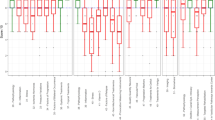Abstract
Purpose
To assess awareness and recognition of vestibular function tests in otorhinolaryngology medical staffs, especially the vestibular evoked myogenic potentials (VEMP) testing in patients with obstructive sleep apnea (OSA).
Methods
A survey was delivered via either email or a social media app. The medical staffs of the Chinese Medical Association of Otolaryngology Head and Neck Surgery from various branches were enrolled. Study data were collected and managed with an online data collection tool.
Results
A total of 1781 emails and 623 social media messages were sent to 2404 otorhinolaryngology medical staffs. One hundred and fifty-seven of them participated in the survey, including 24 via emails and 133 via the social media app. Regarding the knowledge of VEMP, only 59 (37.6%) of them agreed that OSA could be related to vertigo/dizziness/imbalance and 28 (17.8%) believed that OSA could result in VEMP abnormalities and would factor this in diagnosing the impairment of the vestibular function of OSA patients. A total of 7.6% of the respondents had never heard of the VEMP tests. Responses regarding the minimum age at which VEMP are possible ranged from younger than 6 months to greater than 18 years of age. Beliefs regarding the utility and reliability of VEMP varied, with ‘unsure’ being the most frequent response. In addition, only 17.8% of otolaryngologists indicated some access to the VEMP test.
Conclusions
Knowledge and beliefs about the role of VEMP in diagnosing otolithic organ dysfunction caused by OSA in otorhinolaryngology vary widely. It is important for otorhinolaryngology medical staffs to learn the latest literatures and updated knowledge through continuing education.
Similar content being viewed by others
References
Liao WJ, Song LJ, Yi HL et al (2018) Treatment choice by patients with obstructive sleep apnea: data from two centers in China. J Thorac Dis 10(3):1941–1950. https://doi.org/10.21037/jtd.2018.03.135
Zhang JH, Fung SJ, Xi M et al (2010) Apnea produces neuronal degeneration in the pons and medulla of guinea pigs. Neurobiol Dis 40(1):251–264. https://doi.org/10.1016/j.nbd.2010.05.032
Luo HP, Yu J, Xu XD et al (2021) Characteristic manifestation of ocular and cervical vestibular evoked myogenic potentials findings in severe obstructive sleep apnea patients. Acta Otolaryngol 141(81):754–761. https://doi.org/10.1080/00016489.2021.1947524
Bayram A, Dogan M, Koc A et al (2015) Cervical and ocular vestibular evoked myogenic potentials in Behcet’s disease. Am J Otolaryngol 36(4):503–508. https://doi.org/10.1016/j.amjoto.2015.03.004
Xu XD, Ding CR, Yu J et al (2016) The hidden dysfunction of otolithic organs in patients with profound sensorineural hearing loss. Hear Res 331:41–46. https://doi.org/10.1016/j.heares.2015.10.006
Xu XD, Chen BJ, Sun AR et al (2022) Uneven effects of sleep apnea on semicircular canals and otolithic organs. Front Neurol 13:819721. https://doi.org/10.3389/fneur.2022.819721
Oh SY, Kim HJ, Kim JS (2016) Vestibular-evoked myogenic potentials in central vestibular disorders. J Neurol 263(2):210–220. https://doi.org/10.1007/s00415-015-7860-y
Mubashir T, Abrahamyan L, Niazi A et al (2019) The prevalence of obstructive sleep apnea in mild cognitive impairment: a systematic review. BMC Neurol 19(1):195. https://doi.org/10.1186/s12883-019-1422-3
Gao T, Zhang Q, Hou J et al (2020) Vestibular-evoked myogenic potentials in patients with severe obstructive sleep apnea. J Int Med Res 48(31):300060520909717. https://doi.org/10.1177/0300060520909717
Mutlu M, Bayir O, Yuceege MB et al (2015) Vestibular evoked myogenic potential responses in obstructive sleep apnea syndrome. Eur Arch Otorhinolaryngol 272(11):3137–3141. https://doi.org/10.1007/s00405-014-3294-x
Birk R, Dietz M, Sommer JU et al (2020) Nightly hypoxia does not seem to lead to otolith dysfunction in patients with obstructive sleep apnea. Ear Nose Throat J. https://doi.org/10.1177/0145561320922126
Ulusoy B, Gul O, Elsurer C et al (2020) The relationship between the findings of vestibular evoked myogenic potentials and severity of obstructive sleep apnea syndrome. Eur Arch Otorhinolaryngol 277(11):37–46. https://doi.org/10.1007/s00405-019-05654-8
Kayabasi S, Iriz A, Cayonu M et al (2015) Vestibular functions were found to be impaired in patients with moderate-to-severe obstructive sleep apnea. Laryngoscope 125(51):1244–1248. https://doi.org/10.1002/lary.25021
Mutlu M, Bayir O, Yuceege MB et al (2015) Vestibular evoked myogenic potential responses in obstructive sleep apnea syndrome. Eur Arch Otorhinolaryngol 272(111):3137–3141. https://doi.org/10.1007/s00405-014-3294-x
Kayabasi S, Hizli O, Yildirim G (2019) The association between obstructive sleep apnea and hearing loss: a cross-sectional analysis. Eur Arch Otorhinolaryngol 276(81):2215–2221. https://doi.org/10.1007/s00405-019-05468-8
Tsai MS, Lee LA, Tsai YT et al (2018) Sleep apnea and risk of vertigo: a nationwide population-based cohort study. Laryngoscope 128(3):763–768. https://doi.org/10.1002/lary.26789
Micarelli A, Liguori C, Viziano A et al (2017) Integrating postural and vestibular dimensions to depict impairment in moderate-to-severe obstructive sleep apnea syndrome patients. J Sleep Res 26(4):487–494. https://doi.org/10.1111/jsr.12516
Sowerby LJ, Rotenberg B, Brine M et al (2010) Sleep apnea, daytime somnolence, and idiopathic dizziness–a novel association. Laryngoscope 120(6):1274–1278. https://doi.org/10.1002/lary.20899
Xu XD, Hu J, Zhang Q et al (2017) Characteristics and clinical use of ocular and cervical vestibular evoked myogenic potentials for evaluating paediatric candidates for cochlear implants. J Laryngol Otol 131(1):56–63. https://doi.org/10.1017/S0022215116009634
Acknowledgements
Many thanks to Luo Yong-Hao, Li Zhi, Zhou Jie-Lun, and Michael for their supports in spirit. Thanks to Wilson Chen and Jenny Lee for their inspiration in Psychology and Neuro-Linguistic Programming. Thanks to Tom Dong and Jade Chen for their help in the language-editing.
Funding
Supported by National Natural Science Foundation of China (no. 81700915) to X. Xu; The Youth Foundation of Shanghai Municipal Health Commission (no. 20194Y0190) to H. Luo; Shanghai "Rising Stars of Medical Talent" Youth Development Program (Youth Medical Talents-Specialist Program) to X. Xu.
Author information
Authors and Affiliations
Corresponding authors
Ethics declarations
Conflict of interest
None of the authors have potential conflicts of interest to be disclosed.
Additional information
Publisher's Note
Springer Nature remains neutral with regard to jurisdictional claims in published maps and institutional affiliations.
Rights and permissions
Springer Nature or its licensor holds exclusive rights to this article under a publishing agreement with the author(s) or other rightsholder(s); author self-archiving of the accepted manuscript version of this article is solely governed by the terms of such publishing agreement and applicable law.
About this article
Cite this article
Luo, HP., Ren, TL., Zhang, R. et al. The use of vestibular evoked myogenic potentials (VEMP) in the diagnosis of otolithic dysfunction of patients with obstructive sleep apnea: a survey of awareness and recognition of otorhinolaryngology medical staffs. Eur Arch Otorhinolaryngol 280, 1603–1610 (2023). https://doi.org/10.1007/s00405-022-07616-z
Received:
Accepted:
Published:
Issue Date:
DOI: https://doi.org/10.1007/s00405-022-07616-z




